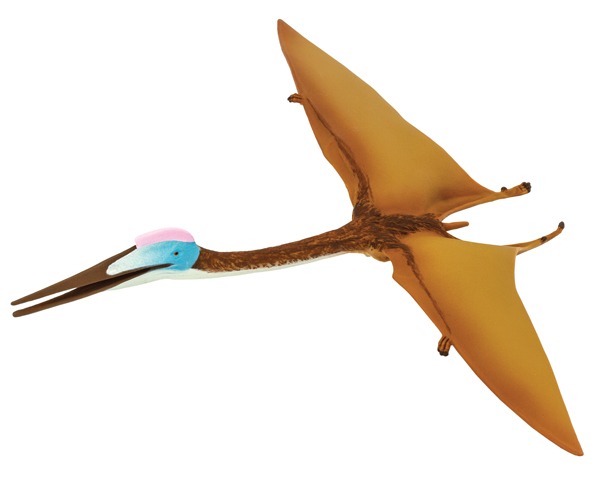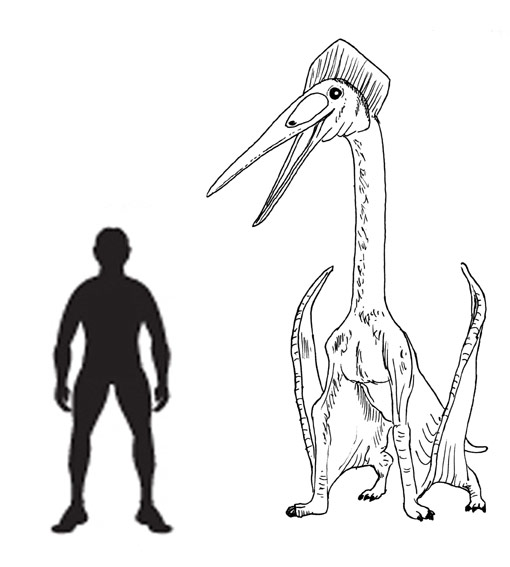Fantastic Pterosaur Terrors for Halloween
Gigantic Pterosaur from the Nemegt Formation of Mongolia
An international team of scientists writing in the “Journal of Vertebrate Paleontology” have described the fragmentary neck bones of a gigantic pterosaur which might turn out to be one of the largest flying reptiles known to science.
It seems apt on “All Hallows’ Eve” to write about a creature, that if it was still around today, would be the stuff of nightmares. The researchers, which include scientists from Tokyo University, Ohio University, the University of Pennsylvania as well as the Mongolian Academy of Sciences, estimate that the reptile could have had a wingspan in excess of 11 metres, perhaps even bigger.
An Azhdarchid Pterosaur – The Stuff of Nightmares
The image (above) shows a replica of the giant azhdarchid pterosaur Quetzalcoatlus. This model features in the Safari Ltd model range.
To view this range: Wild Safari Prehistoric World Dinosaurs and Pterosaurs.
Fragmentary Fossil Evidence
The fragmentary fossils were found in 2006, during a field expedition to the western Gobi Desert to explore a fossil-rich series of sediments known as Gurilin Tsav. Field team member and co-author of the scientific paper, Buuvei Mainbayar (Mongolian Academy of Sciences) found the first piece of a cervical vertebrae and showed it colleague Takanobu Tsuihiji (Tokyo University), who is the lead author of the paper. More pieces of neck bone were found, but such was their fragmentary nature that it has taken more than a decade to complete an identification and publish data.
The bones have been assigned to an azhdarchid pterosaur. The deposits around Gurilin Tsav date from the Upper Campanian to the Maastrichtian faunal stage of the Late Cretaceous. These fossils represent the first azhdarchid fossils to have been found in the Nemegt Formation, in fact these are the first reported Pterosaur remains from this famous Formation.
A comparison between these fossilised neck bones and those of other, slightly better-known members of the Late Cretaceous pterosaur family known as the Azhdarchidae, indicate that the fossil material represents a “giant amongst giants”. One of the neck bones measures nearly 20 centimetres in diameter, this is nearly four times as wide as the equivalent bone found in the huge azhdarchid pterosaur from the Late Cretaceous of Jordan (Arambourgiania).
The Azhdarchid Pterosaurs
It is not known whether this, as yet unnamed pterosaur had an exceptionally, thick, strong neck or whether the rest of its skeleton was much bigger than the likes of Hatzegopteryx or Quetzalcoatlus, hopefully, more fossils will be found. This discovery provides further evidence that the Azhdarchidae were widely distributed across North America, Europe and Asia around 70 million years ago – not surprising really as these aerial giants would have been capable of flying incredibly long distances.
A Scale Drawing of the Giant Azhdarchid Pterosaur from Transylvania Hatzetgopteryx thambema
Picture credit: Everything Dinosaur
The scientific paper: “Gigantic Pterosaurian remains from the Upper Cretaceous of Mongolia” by Tsuihiji, T., B. Andres, P. M. O’Connor, M. Watabe, K. Tsogtbaatar, and B. Mainbayar published in the Journal of Vertebrate Paleontology.
Visit the award-winning Everything Dinosaur website: Everything Dinosaur.



